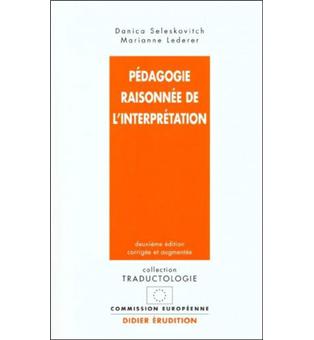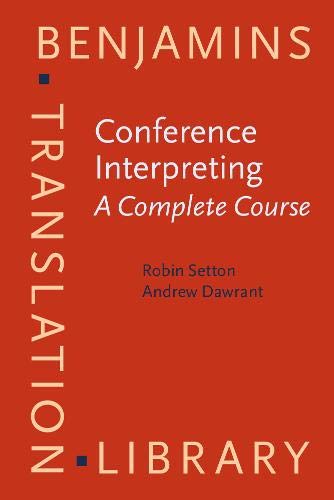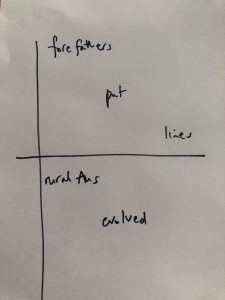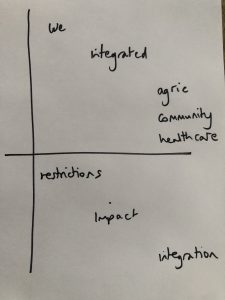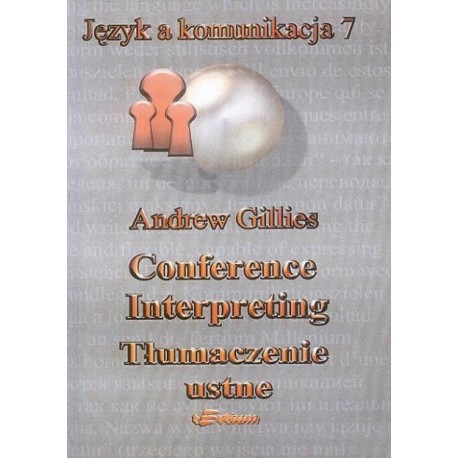Pedagogie Raisonnee De L’interpretation (Traductologie) (Volume 4) (French Edition) (9782864606406): Lederer, Marianne, Seleskovitch, p27-33.
Download the full work as a pdf
ANALYSE
2.1. Visualiser
2.2 Repérer les étapes chronologiques
2.3 Ecouter l’ordre de grandeur des chiffres
2.4 Associer des idées aux termes qui possèdent des correspondances
2.5 Dégager les enchaînements
2.1. Visualiser
Parmi les premiers moyens qu’il convient de recommander aux étudiants pour les concentrer sur le sens et les empêcher de s’attarder sur les mots, figure la visualisation. Voir mentalement un objet ou imaginer les aspects d’un événement dont on entend parler, c’est en entendre le sens. L’image que les étudiants se feront des événements narrés dans le discours leur permettra de moins écouter les mots et de s’exprimer à partir de ce qu’ils se sont représenté en imagination.
Il faut ici faire la distinction entre les narrations et les descrip- tions, qu’il faut éviter à ce stade ; celles-ci nécessiteraient en effet, contrairement au but souhaité, un redoublement de l’attention por- tée aux détails de la description pour en assurer la traduction ; la narration en revanche évoque plus qu’elle ne décrit. Un passage narratif comme l’extrait de l’exposé que nous reproduisons ci-des- sous se prête aisément à un exercice de visualisation :
« Getting food to Ethiopia is a lot easier than actually delivering it to the people in need. The main port at Assab and the main airfield at Addis Ababa are badly jammed ; the roads leading to the interior are clogged and there’s also a shortage of petrol. Sometimes it’s a question of having too much food with too little coor- dination. The response that we have had for Ethiopia has been magnificent but now in Ethiopia there is an example of 54 aeroplanes waiting to be unloaded at
an airport which can normally only deal with 3 or 4 planes a day.
Everybody wants to be the first to send in relief but that is not always a good thing ; there are cases of wastage of food although the officials don’t like to say so, as it might stop people from contributing».
On peut susciter des images presque à chaque phrase : « The main port… and the main airfield are badly jammed… the roads are clogged… there is a shortage of petrol… 54 aeroplanes waiting to be unloaded. » L’image ne correspondra peut-être pas à la réa- lité : des yeux occidentaux verront « shortage of petrol » sous forme de queues aux stations d’essence ou des stations-service tristement fermées, image peu probable sur les routes éthiopiennes, mais qui permettront sans mal de parler du manque d’essence.
L’évocation d’images reliées entre elles par une argumentation facile donne une grande précision de perception et une non moins grande facilité d’expression. Au début, le débutant a encore du mal, il cherche ses mots, colle à nourriture pour food, s’effarouche du nom du port qu’il ignore (Assab), s’efforce de retenir le nombre, sans grande importance, des avions immobilisés (54). L’idée prin- cipale ressort cependant : « Le problème n’est pas tant de recevoir de la nourriture que de l’acheminer là où on en a besoin ».
On relèvera dans ce genre de discours tous les passages qui auraient dû être « vus » alors que l’on n’insistera pas forcément encore sur des fautes qui, relevant d’autres phénomènes, devront être traitées séparément et ultérieurement, au moment où l’étudiant aura désappris à écouter et retenir des mots. Exemple d’une faute qu’on ne corrige pas encore : l’original dit « Everybody wants to be the first to send in relief ». S’agissant des pays occidentaux sou- cieux, non seulement d’apporter leur aide, mais aussi d’accroître leur influence dans cette partie du monde, le sous-entendu est com- plexe ; il n’est pas saisi à ce stade où les étudiants ont encore des associations d’idées stéréotypées et voient des mains tendues quand il est question d’aide. « Chacun veut être le premier à rece- voir », dit l’étudiant. Cette faute est compréhensible en début de formation. Elle sera relevée mais ne sera pas encore reprochée à l’étudiant.
De nombreux exercices de visualisation sont nécessaires ; car l’habitude d’écouter des mots au lieu de voir les images qu’ils évo- quent est bien ancrée. Il est difficile au début de faire voir les images et par là même de faire oublier les mots ; ainsi dans les camps de réfugiés éthiopiens :
« Many people are too weak to be able to eat and that means that they have had to install a system called “wet feeding” with grains and mash and it’s mixed with water and it gurgles down easier, mixed with water ».
« Wet feeding » a donné lieu à la recherche frénétique d’un terme qui correspondrait en français ; l’enseignant a eu du mal à obtenir que l’idée soit reprise dans son ensemble, une fois visuali- sée la situation : les gens sont trop faibles pour absorber des ali- ments solides, il faut leur faire ingurgiter de la nourriture liquide, des bouillies plus faciles à avaler que des solides. Par ailleurs une expression telle que « Children have forgotten how to eat, comple-tely forgotten how to eat » devrait faire surgir l’image d’un petit enfant aux membres grêles et au ventre ballonné, assis, le regard hébété, comme on en a hélas vu trop souvent en photo ; elle ne donne encore qu’un calque affligeant : « Les enfants ont oublié comment manger ». (Ils ont oublié leurs bonnes manières ?).
2.2. Repérer les étapes chronologiques
Prendre la mesure du temps, noter mentalement les étapes qui se succèdent dans une narration constitue une autre technique d’ap- proche du sens et, par la même occasion, du rejet des mots et de la recherche de leurs correspondances. Le texte sur Hong-kong donné au § 1.2. ci-dessus peut par exemple être articulé en éléments suc- cessifs : examen par le Parlement Britannique de l’accord sur Hongkong ; visite de Madame Thatcher à Pékin ; règlement du sort de la dernière parcelle du territoire ; législation chinoise ; départ britannique ; retour au début de la chaîne d’événements ; accepta- tion des habitants de Hongkong devant être portée à la connais- sance du Parlement Britannique ; difficulté de réalisation de l’en- quête ; quelques réponses ; un sondage donne néanmoins une idée.
Ce type d’analyse séquentielle apprend à faire le tri dans les informations présentées. Les étudiants peuvent compter sur leurs doigts les événements qui se succèdent (peu importe qu’ils en trou- vent 9 ou seulement 6 ou 7), ils sauront quoi écouter et feront à leur insu une première ébauche de prise de notes.
2.3. Ecouter l’ordre de grandeur des chiffres
Il suffit d’entendre les paroles porteuses d’arguments, d’images, d’idées, pour les comprendre sans qu’il soit vraiment besoin de les écouter ; les chiffres exigent une écoute différente. Lorsqu’ils ne s’associent pas à des connaissances antérieures, faute par consé- quent de susciter des compléments cognitifs, ils ne présentent à l’audition que leur forme. Or, on sait qu’une forme n’est guère dis- cernable si, partiellement perçue, elle ne réveille pas une connais- sance chez l’auditeur qui la complète alors par suppléance mentale. L’ordre de grandeur des chiffres est plus facile à entendre et à rete- nir que l’intégralité de leur forme sonore. Dans le fil du discours, « trente cinq mille quatre cent quatre vingt douze » sera difficile- ment perçu intégralement. L’ordre de grandeur « trente cinq mille » peut être retenu alors que chercher à entendre intégralement se tra- duit souvent par une erreur grossière.
Les étudiants apprendront plus tard à noter correctement les chiffres en consécutive, et à les redire correctement en simultanée, en faisant passer leur attention alternativement de l’écoute du sens à l’écoute des signifiants. Dans un premier stade, il leur faut apprendre à écouter les ordres de grandeur. Soit l’extrait suivant :
« Asia — the biggest continent on earth occupies 26 % of the global surface and supports some 58 % of the total world population. Of the 71 million childbirths each year, 46 million take place in Asia. It is a continent of extremes as is evi- dent from a sample of following statistics… ».
La restitution correspond bien à ce qui est demandé :
« L’Asie est le continent le plus important du monde et en couvre à peu près le quart de la superficie… du globe. Sa population représente plus que… la moitié de la population mondiale. Et sur le nombre de naissances annuelles, on dépasse aussi aisément la moitié du chiffre mondial ».
Les chiffres sont « compris », ils pourront ultérieurement être notés correctement, c’est-à-dire sans erreur d’ordre de grandeur. L’étudiant a suivi les directives de l’enseignant ; le type d’attention qu’il a porté aux chiffres l’a en outre libéré du littéralisme fréquent en début d’études, sans qu’il atteigne pour autant l’aisance et la correction d’expression qu’il possédera plus tard.
En apprenant à écouter les chiffres en vue de l’exercice futur du métier, les étudiants apprennent à faire varier leur concentration auditive ; ils opèrent une distinction entre les signifiants sur les- quels il faut qu’ils concentrent leur attention et ceux qu’il convient de laisser filer pour éviter qu’ils ne fassent écran aux idées.
2.4. Associer des idées aux termes qui possèdent des correspondances
Parmi les signifiants sur lesquels il faut concentrer l’attention auditive figurent les termes ‘ : mots monosémiques, chiffres indi- quant des quantités, noms propres, termes techniques. Ces termes n’ont pas besoin d’être interprétés, ils peuvent passer d’une langue à l’autre par application de correspondances pré-existantes. Ce sont les mots qui devront être notés en consécutive et pour lesquels, plus tard encore, les étudiants devenus interprètes se constitueront des fiches terminologiques qu’ils consulteront avant chaque simultanée pour un domaine donné.
Le caractère transcodable de ces termes ne doit cependant pas faire croire qu’il est inutile de les comprendre ; ils jouent en tout état de cause un rôle dans l’ensemble de la phrase — nous venons de le voir pour les chiffres — et leur non-compréhension risquerait de se réper- cuter sur l’ensemble de l’idée. En outre, vu le rythme de l’oral, il est souvent plus facile de comprendre la fonction ou la nature de la chose désignée par un terme, que de percevoir très nettement la structure phonétique du terme même. L’oral est à cet égard différent de l’écrit, où le terme peut attendre la consultation d’un livre de référence pour livrer son secret et permettre sa traduction ; les étudiants qui tra- vaillent toujours sur un oral evanescent doivent apprendre à toujours comprendre en une seule audition et à toujours faire comprendre en une formulation unique le mot transcodable. Ce n’est pas impossible.
Prenons un exemple tiré d’un exposé traitant des armes chi- miques et biologiques :
« Genetic engineering has progressed to such a degree that scientists can now program the genes of certain germs to produce specific effects in a population, for example sterility, or they can preprogram the genes of germs and target them on specific ethnic groups in order to eliminate them.
Scientists developed a strain of botulism that is so virulent that a single suitcase full of it is enough to eliminate all human life on our planet ».
Strain of botulism arrête l’étudiant qui cherche comment tra- duire ; le passage tout entier traitant de guerre bactériologique, il est évident que dans ce contexte botulism pourrait être rendu par un générique : agent pathogène, ou même produit contagieux… Il est trop tôt pour insister sur la correspondance de souche pour strain qui aura plus tard son importance ; pour l’instant les étu- diants doivent apprendre à utiliser le contexte pour compenser par l’intelligence et le raisonnement les défauts d’audition ou les lacunes terminologiques qu’ils rencontrent.
2.5. Dégager les enchaînements
Nous avons vu au § 2.2 ci-dessus qu’il peut être utile de dégager la séquence d’une série d’événements ; il faut aussi apprendre à distinguer les idées qui mènent les unes aux autres, à retenir leur enchaînement. Les rapports de cause à effet, les liaisons entre les idées sont des éléments importants pour la constitution du sens.
Dans une masse de données verbales, il faut apprendre à donner à chaque idée sa juste valeur et à l’enchaîner correctement à cha- cune des autres.
Soit l’information suivante à propos de la mortalité infantile en Asie :
« Approximately 33 % of the deaths in the pre-school age group can be attribu- ted to poor environmental sanitation. Less than 15 % of rural population live within a walking distance of 10 kilometers of a health facility of any kind. A Bangladesh doctor has said : “In the Philippines and certainly more so in other Asian countries, including Bangladesh, about 70 % of the people die without seeing a doctor. According to 1978 data, the life expectancy at birth is 58 in Asia and 71 in Europe as against the world average of 60 years”. »
L’exercice est difficile car les idées doivent être intuitivement reclassées à l’écoute en idées principales et idées secondaires et enchaînées de façon à faire ressortir ce qui est l’argument et ce qui est dit à titre d’exemple : le manque de médecins (2e et 3e phrases) n’est qu’une illustration de la constatation générale énoncée dans la première. La quatrième phrase par contre aborde un thème nouveau : la comparaison de l’espérance de vie en Asie et en Europe. Il est évident que cette analyse ne peut pas être faite expli- citement mais il est tout aussi évident que se lancer de mémoire dans une traduction sans avoir compris le rapport des idées entre elles est sans espoir.
Des restitutions du type qu’on lira ci-dessous prouvent que les idées principales n’ont pas été clairement dégagées :
« La mortalité dans les premières années de la vie en Asie est de… 30 %… ensuite il y a cette histoire du médecin du Bangladesh qui dit que 70 % des gens mouraient sans avoir vu un médecin et que… il y avait… un éloignement d’au moins 10 km entre l’habitat et le premier centre de soins ou le premier centre de santé »
Avant de progresser, il faut revenir à des analyses par segments moins importants, jusqu’à ce qu’on obtienne les trois points sui- vants : a) forte mortalité infantile en l’absence d’infrastructure médicale ; b) 70 % des gens, notamment aux Philippines et au Bangladesh, ne voient jamais de médecin ; c) l’espérance de vie en Asie est nettement inférieure à celle d’Europe.
On fait alors réentendre l’ensemble du passage et, une fois obte- nue une restitution à peu près correcte, on souligne l’importance très inégale des mots qui signalent les idées : par exemple dans « die without seeing a doctor », ce n’est pas die qui compte, mais bien l’idée que jamais ces gens n’ont la possibilité de consulter un méde- cin. C’est en se concentrant sur l’idée que les étudiants peu à peu arriveront à dire « ne voient jamais un médecin de leur vie », et non « meurent sans voir un médecin », qui donne l’impression que les malheureux meurent sans qu’aucun médecin ne soit présent.
Dans le même passage, c’est en se concentrant sur les idées que l’on comprendra la phrase : « Less than 15 % of rural population live within a walking distance of 10 km of a health facility of any kind » comme signifiant que la grosse majorité des gens n’ont pas la possibilité de se faire soigner.
Le discours travaillé en interprétation ne se répétant jamais, la correction d’une faute n’a d’effet formateur que si la catégorie d’er- reur est expliquée ; l’enseignant ira donc au-delà de la correction ponctuelle en rappelant certains principes. Dans l’exemple ci-dessus, afin de ne pas simplement corriger une faute et afin d’éviter que des erreurs analogues se reproduisent, on expliquera que pour résister au littéralisme de « meurent sans voir un médecin » pour « die without seeing a doctor », il faut avoir gardé à l’esprit la description de la situation sanitaire en Asie et laissé échapper les mots anglais. On fixe par cet exemple les principes généraux de l’apparition d’un sens : association d’un sémantisme verbal et de compléments cognitifs per- tinents puis déverbalisation. On rappellera aux étudiants que le trans- codage fausse le sens et que tenir compte de l’ensemble d’un pas- sage permet de le restituer correctement ; on insistera sur les méfaits de l’utilisation abusive de correspondances, sur la nécessité de ne pas s’accrocher à la formulation originale, et on fera comprendre la notion d’équivalence. Peu à peu les étudiants finissent par trouver dans leur langue maternelle des expressions naturelles et donc claires : 70 % des gens n ‘ontjamais vu de médecin de leur vie, 70 % des gens n ‘ont jamais pu se faire soigner ou encore 70 % des gens meurent sans jamais avoir vu de médecin. Ces trois expressions sont l’équivalence de l’anglais, elles expriment toutes trois le même sens que lui, si différents que soient les mots qui les composent.
Qu’est-ce qui permet de traduire ainsi par équivalences si ce n’est le fait d’avoir des connaissances, apportées par la télévision, le cinéma ou des publications, sur les conditions de vie qui régnent dans ces régions ? Cette connaissance complète cognitivement l’anglais, formant un tout qui peut alors s’exprimer dans n’importe quelle langue sans qu’il soit nécessaire de se référer à la langue de départ.


